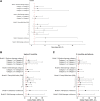Exposure-response relationship of residential dampness and mold damage with severe lower respiratory tract infections among under-five children in Nigeria
- PMID: 37064421
- PMCID: PMC10097558
- DOI: 10.1097/EE9.0000000000000247
Exposure-response relationship of residential dampness and mold damage with severe lower respiratory tract infections among under-five children in Nigeria
Abstract
Previous epidemiological studies demonstrated an increased risk of respiratory health effects in children and adults exposed to dampness or mold. This study investigated associations of quantitative indicators of indoor dampness and mold exposure with severe lower respiratory tract infections (LRTI) among children aged 1-59 months in Ibadan, Nigeria.
Methods: In-home visits were conducted among 178 children hospitalized with LRTI matched by age (±3 months), sex, and geographical location with 180 community-based children without LRTI. Trained study staff evaluated the indoor environment using a standardized home walkthrough checklist and measured visible dampness and mold damage. Damp-moldy Index (DMI) was also estimated to quantify the level of exposure. Exposure-response relationships of dampness and mold exposure with severe LRTI were assessed using multivariable restricted cubic spline regression models adjusting for relevant child, housing, and environmental characteristics.
Results: Severe LRTI cases were more often male than female (61.8%), and the overall mean (SD) age was 7.3 (1.35) months. Children exposed to dampness <0.3 m2 (odds ratio [OR] = 2.11; 95% confidence interval [CI] = 1.05, 4.36), and between 0.3 and 1.0 m2 (OR = 2.34; 95% CI = 1.01, 7.32), had a higher odds of severe LRTI compared with children not exposed to dampness. The restricted cubic spline showed a linear exposure-response association between severe LRTI and residential dampness (P < 0.001) but a nonlinear relationship with DMI (P = 0.01).
Conclusions: Residential dampness and DMI were exposure-dependently associated with higher odds of severe LRTI among under-five children. If observed relationships were causal, public health intervention strategies targeted at reducing residential dampness are critically important to mitigate the burden of severe LRTI among under-five children.
Keywords: Dampness; Nigeria; epidemiology; lower respiratory tract infections; mold exposure; under-five children.
Copyright © 2023 The Authors. Published by Wolters Kluwer Health, Inc. on behalf of The Environmental Epidemiology. All rights reserved.
Conflict of interest statement
The authors declare that they have no conflict of interest with regard to the content of this report.
Figures


Similar articles
-
Indoor bacterial and fungal aerosols as predictors of lower respiratory tract infections among under-five children in Ibadan, Nigeria.BMC Pulm Med. 2022 Dec 9;22(1):471. doi: 10.1186/s12890-022-02271-w. BMC Pulm Med. 2022. PMID: 36494686 Free PMC article.
-
Respiratory Diseases in University Students Associated with Exposure to Residential Dampness or Mold.Int J Environ Res Public Health. 2016 Nov 18;13(11):1154. doi: 10.3390/ijerph13111154. Int J Environ Res Public Health. 2016. PMID: 27869727 Free PMC article.
-
Exposure to residential mold and dampness and the associations with respiratory tract infections and symptoms thereof in children in high income countries: A systematic review and meta-analyses of epidemiological studies.Paediatr Respir Rev. 2023 Dec;48:47-64. doi: 10.1016/j.prrv.2023.06.003. Epub 2023 Jun 17. Paediatr Respir Rev. 2023. PMID: 37482434 Review.
-
Childhood lower respiratory tract infections linked to residential airborne bacterial and fungal microbiota.Environ Res. 2023 Aug 15;231(Pt 1):116063. doi: 10.1016/j.envres.2023.116063. Epub 2023 May 6. Environ Res. 2023. PMID: 37156352
-
Association of residential dampness and mold with respiratory tract infections and bronchitis: a meta-analysis.Environ Health. 2010 Nov 15;9:72. doi: 10.1186/1476-069X-9-72. Environ Health. 2010. PMID: 21078183 Free PMC article. Review.
References
-
- Troeger C, Forouzanfar M, Rao PC, et al. . Estimates of the global, regional, and national morbidity, mortality, and aetiologies of lower respiratory tract infections in 195 countries: a systematic analysis for the Global Burden of Disease Study 2015. Lancet Infect Dis. 2017;17:1133–1161. - PMC - PubMed
-
- Liu L, Johnson HL, Cousens S, et al. ; Child Health Epidemiology Reference Group of WHO and UNICEF. Global, regional, and national causes of child mortality: an updated systematic analysis for 2010 with time trends since 2000. Lancet. 2012;379:2151–2161. - PubMed
LinkOut - more resources
Full Text Sources
